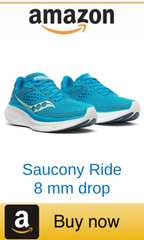Choosing the right running shoes for Achilles tendonitis
- Steph Davies
- Feb 13, 2023
- 4 min read
Updated: Mar 12
Our patients often ask us: “What are the best running shoes for Achilles tendonitis?” In this article, we discuss things you should consider when choosing a pair of running shoes when you have Achilles pain. Remember, if you need more help with an Achilles injury, you're welcome to consult one of our team via video call.

The terms tendinitis, tendonitis, tendinosis, and tendinopathy mean the same thing for all practical purposes, and we use these interchangeably in our articles.
Some of the links in this article are to pages where you can buy products discussed or mentioned here. We might earn a small commission on sales at no extra cost to you.
In this article:
We’ve also made a video about this:
The shoes have to be comfortable
First of all, you have to feel comfortable when you’re running in your shoes.
There's absolutely no point in going to run on a treadmill to have a video taken for a gait analysis, only to be prescribed a pair of shoes that you hate running in. This happened to me, and it totally defeats the purpose.
Heel-to-toe drop
Comfort is a subjective thing. In terms of measurables, heel-to-toe drop is the most important variable in a running shoe that can have an influence on your Achilles tendon.
Heel-to-toe drop refers to how much higher the heel of the shoe is than the toe, and this is measured in millimetres.
Standard running shoes have a heel-to-toe drop of around 8 mm (⅓ inch), and you get some that go up to 12 mm. Shoes with a drop of 4 mm and less are referred to as minimalist shoes, and the term “zero-drop shoes” speaks for itself.

Zero-drop or minimalist shoes vs. shoes with a bigger drop
The amount of heel-to-toe drop is relevant for Achilles problems, because biomechanical research has shown that the flatter the drop, the more stress and load the Achilles tendon – and to some degree the plantar fascia, the metatarsals, and your calf muscles – have to endure.
So, when you're running in a minimalist or a zero-drop shoe, you’re requiring more of your Achilles tendon.
This doesn't mean that you can never run in a zero-drop shoe again after an Achilles injury, but it might take you longer to get the strength and conditioning in your Achilles tendon and your calf good enough to tolerate it.
Ankle flexibility
Another factor that could influence your choice of heel-to-toe drop is how flexible your ankle is. More flexible ankles will be able to move through the range of motion that running in minimalist or zero-drop shoes requires, whereas stiffer ankles will do better in a pair of shoes with a good amount of heel-to-toe drop.
Other injuries
However, a big heel-to-toe drop may not necessarily work for you; while they reduce the load on your Achilles tendon and calves, the strain is then transferred to other parts of your body. So, if you have knee or hip issues, shoes with a big drop may sometimes exacerbate those.
Some men's runnning shoes with a range of heel-to-toe drops
Some women's running shoes with a range of heel-to-toe drops
Hardness of the heel cup
When you try on running shoes, check that the heel cup – the top part of the shoe at the back – doesn’t dig into your injured Achilles tendon.
This is particularly important for people with heel bursitis or insertional Achilles tendinopathy, where the injury is right on the heel bone. However, the heel cup of some shoes comes up so high that it can even dig into a higher-up mid-portion Achilles tendinopathy.
Then, when shoes get worn out a bit, the heel cup can change in such a way that it starts digging into or rubbing on an Achilles injury, so keep an eye on that.
And lastly, when you put a heel lift orthotic in your shoe to take the strain off your Achilles tendon (an on-the-fly increase in your heel-to-toe drop, if you will), check that this doesn’t push the injured bit into a position where the heel cup will now cause you pain.
Sort out other problems before focusing on shoes
Try and figure out whether your Achilles injury is actually caused by your running shoes. If your shoes aren’t the cause, changing them won’t fix your tendon – at best it will help to alleviate the pain.
My colleague Maryke wrote an article about how shoes can cause Achilles tendon injuries.
If you’re not sure whether your Achilles pain is caused by your shoes, it is best to get the injury checked out by a medical professional. There might be something very simple you can do to sort it out. And the sooner you do something about it, the shorter the healing time.
How we can help
Need more help with your Achilles injury? You’re welcome to consult one of the team at TMA online via video call for an assessment of your injury and a tailored treatment plan.
We're all UK Chartered Physiotherapists with Master’s Degrees related to Sports & Exercise Medicine. But at Treat My Achilles we don't just value qualifications; all of us also have a wealth of experience working with athletes across a broad variety of sports, ranging from recreationally active people to professional athletes. You can meet the team here.

About the Author
Steph Davies is a chartered physiotherapist with more than 15 years' experience and a Master’s Degree in Sports and Exercise Medicine. You can follow Steph on LinkedIn.
























